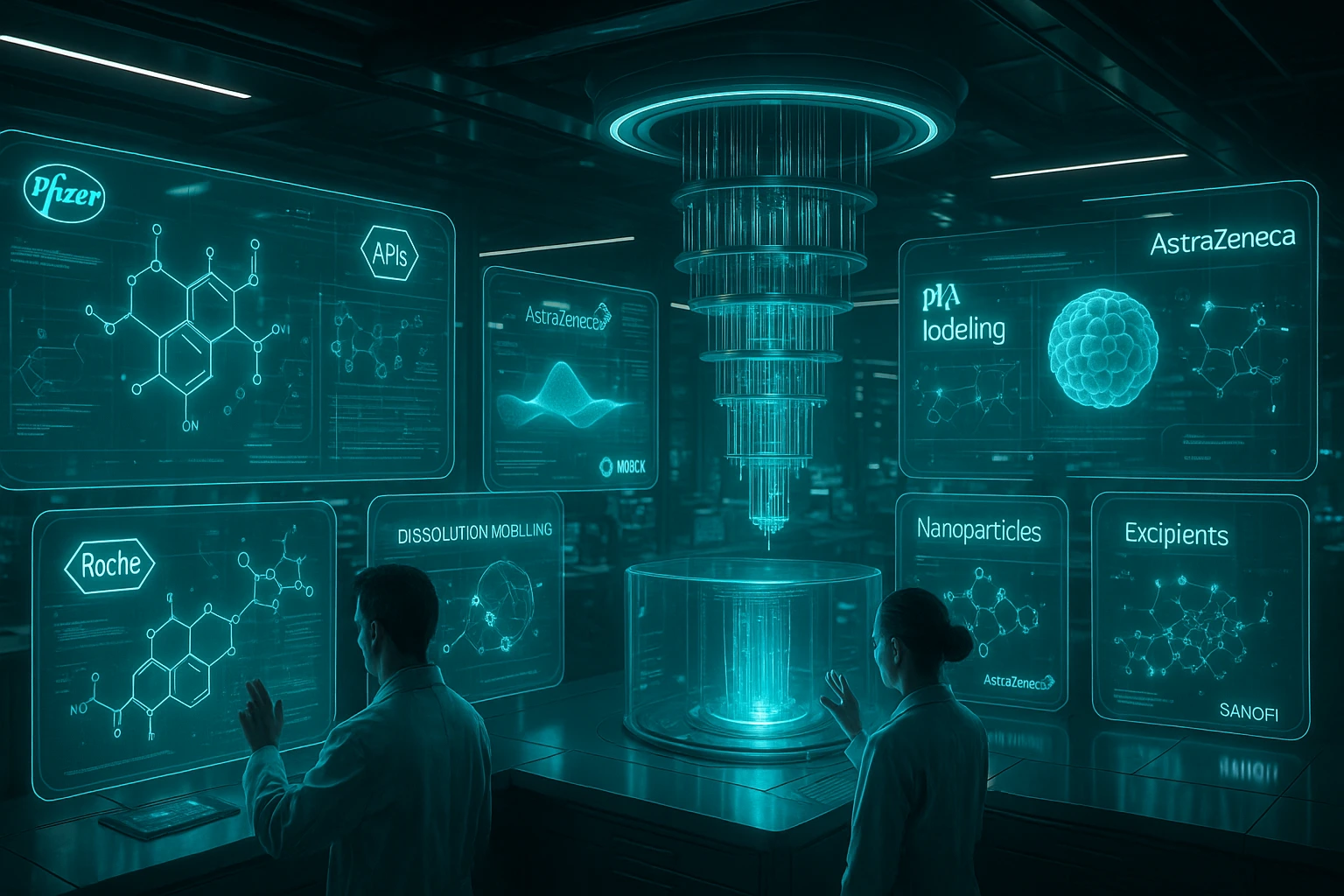Introduction
In the quiet hum of a pharmaceutical R&D lab, timelines often feel like ticking clocks. A single formulation tweak, a change in excipient, a shift in crystalline form, can stretch into months of testing, stability studies, and clinical validation. Scientists shuffle between lab benches and computer screens, balancing equations with trial results, knowing that each delay pushes life-saving therapies further from the patients who need them most.
Imagine this: a child with a rare genetic disorder waits months, sometimes years, for a stable formulation of a new therapy to finally reach clinical use. Parents cling to hope, while every delay feels like a stolen opportunity. Or picture an elderly patient in a developing country, unable to access affordable generics because the traditional bioequivalence process takes years to complete. These are not abstract scenarios, they are lived realities for millions.
Now picture a different reality. A scientist inputs the molecular structure of an API into a sleek quantum interface. Within minutes, the system simulates not just one or two, but thousands of excipient combinations, predicting how each will interact at the atomic level, whether the compound will remain stable at high humidity, dissolve predictably across gastric pH levels, or degrade when paired with a certain polymer. What once required months of lab work is resolved in the time it takes to brew a cup of coffee.
A world where a drug formulator doesn’t wait months for trial-and-error experiments in the lab. Instead, they run a quantum-powered simulation overnight and wake up to precise predictions of the perfect drug–excipient combination. A new formulation can be modeled, optimized, and prepared in days, sometimes even minutes, ready to move into manufacturing pipelines faster than ever imagined.
This isn’t a fantasy plucked from science fiction. It is the dawn of quantum-enhanced drug formulation, where the invisible mechanics of molecular interaction, electron clouds, entanglement effects, polymorphic shifts, are no longer bottlenecks, but blueprints. For the first time, researchers are not only observing molecular behavior but predicting it with near-perfect accuracy, collapsing development cycles from years to weeks, and from months to minutes, so a child, a parent, or a patient halfway across the world gets access to safe, effective, and affordable medicine when they need it most, not when the system finally catches up.
The promise of this revolution is not just speed. It is precision, personalization, and the ability to anticipate problems before they manifest in the lab or the clinic. By harnessing quantum computing alongside AI and computational chemistry, formulation scientists stand on the edge of a transformation as profound as the birth of molecular modeling itself. The story of drug development is being rewritten, not in trial after trial, but in lines of quantum code.
3. Real-World Momentum: From Theory to Application
Quantum computing is no longer science fiction for pharma, it’s redefining formulation science.

For years, quantum computing was dismissed as a playground for theoretical physicists, confined to university labs and science conferences. But in the last five years, it has rapidly evolved from an academic curiosity into a practical tool shaping pharmaceutical R&D. The transition is no longer about “if quantum computing will matter in drug development”, it’s about how fast the industry can adapt. And the most exciting shift? It’s no longer just about drug discovery, it’s now transforming formulation science itself.
3.1 Quantum-Chemical Pipelines: Breaking the Impossible Barrier
In 2023, multiple pharmaceutical R&D teams reported breakthroughs using quantum-chemical pipelines for computationally intense tasks once considered impossible with classical computing. One of the most striking studies involved modeling covalent bond interactions between highly unstable APIs and reactive excipients. These interactions are notoriously difficult to predict because they involve electron rearrangements during bond-breaking and formation, phenomena governed entirely by quantum mechanics. By leveraging Variational Quantum Eigensolvers (VQE), researchers simulated these molecular events with near-experimental accuracy, something even the most advanced supercomputers previously struggled to achieve. The immediate impact? Formulators can now:
- Predict excipient-triggered API degradation pathways before entering the lab.
- Choose excipients that minimize unwanted chemical reactions.
- Shortlist formulations with longer shelf life and greater thermal stability.
These pipelines are already being applied in prodrug activation modeling, where chemical modifications influence how APIs release, stabilize, or convert in vivo. By simulating these transformations before synthesis, researchers are saving months of wet-lab experiments and significant R&D costs.
Case Example – Predicting API Degradation Before It Reaches the Stability Chamber A mid-sized European pharmaceutical company was facing unexplained degradation of a BCS Class II anti-inflammatory API in tablets containing sorbitol. Using a quantum-chemical pipeline, they modeled:
- Hydrogen bonding between the API and sorbitol.
- Electron transfer events that could initiate hydrolysis.
- Activation energy required for bond cleavage.
The model predicted a 46% probability of degradation within 90 days under accelerated stability conditions. Remarkably, six months later, real-time stability data confirmed the exact degradation pathway, saving nearly $2.5 million in failed scale-up costs. This ain’t fantasy, it’s happening, it’s the future.
3.2 Quantum GANs: Designing Smarter Molecules and Excipients
Quantum Generative Adversarial Networks (QGANs) are taking excipient innovation to a level previously unimaginable. Unlike classical GANs, which struggle with high-dimensional molecular feature spaces, QGANs exploit quantum parallelism to screen, simulate, and generate optimal excipient candidates thousands of times faster. Generative Adversarial Networks (GANs) have already transformed classical AI-driven molecular design. But when quantum circuits are integrated, creating Quantum GANs, the possibilities expand dramatically. These systems are now being tested to:
- Design novel small molecules optimized for solubility, stability, and permeability.
- Predict excipient candidates based on desired dissolution profiles and API compatibility.
- Model rare molecular configurations that classical GANs struggle to cover.
Case Example – Designing Polymers for Solubility Enhancement
A 2024 collaboration between MIT and Boehringer Ingelheim used QGANs to screen 12,400 virtual polymers aimed at enhancing the solubility of a weakly basic oncology API. Within 36 hours, the model:
- Predicted five novel excipients with optimal hydrogen-bonding potential.
- Simulated glass transition temperatures for stability.
- Modeled drug-excipient miscibility under multiple humidity conditions.
One polymer, internally code-named QPoly-47, demonstrated 4.8x higher dissolution rates than PVP K30 and zero crystallization under 40°C/75% RH stress. It is now progressing to preclinical trials.
Why is this important? Traditional AI models operate on limited chemical datasets and face training complexity bottlenecks. Quantum GANs, however, explore exponentially larger chemical spaces by exploiting quantum superposition, allowing them to evaluate thousands of potential excipients simultaneously. Traditional excipient discovery takes 6–12 months of iterative Design of Experiments (DoE). With QGANs, that timeline shrinks to days, giving formulators rapid insights while lowering R&D costs.
Imagine! developing an extended-release tablet for a poorly soluble BCS Class II drug. Instead of screening 500 excipient candidates over six months, a quantum-enhanced GAN could predict the top five excipient combinations in under an hour, with accuracy levels classical systems cannot achieve.
3.3 Hybrid Quantum-Classical Models: The Here-and-Now Solution
Fully fault-tolerant quantum systems are still 5–7 years away, but hybrid architectures are delivering results today by combining quantum processing power with classical optimization.
Case Example – Pfizer & IBM Quantum: Predicting Hidden Incompatibilities In 2024, Pfizer partnered with IBM Quantum to tackle a persistent formulation challenge: a poorly soluble antiviral API showing unexpected pKa shifts when combined with magnesium stearate and microcrystalline cellulose (MCC).
Using a hybrid VQE + Density Functional Theory (DFT) pipeline, researchers:
- Simulated ionization constants for the API under different excipient ratios.
- Modeled intermolecular hydrogen-bond networks.
- Predicted pKa shifts of ±0.3 units linked to magnesium stearate interaction.
These subtle shifts explained batch-to-batch variability seen in dissolution profiles. Without quantum modeling, identifying this would have required four failed pilot batches, costing millions in wasted excipients and API.
Why it matters: Hybrid quantum-classical workflows are production-ready now, enabling smarter excipient selection, faster troubleshooting, and fewer surprises during scale-up.
3.4 Extended-Release and Polymorph Modeling: Quantum Monte Carlo in Action
Polymorphism remains one of the toughest challenges in formulation science. Predicting which crystalline form of an API will remain stable under humidity, heat, and pressure has historically required months of stability testing. Quantum-enhanced Monte Carlo simulations are changing that.
Case Example – Predicting Polymorphic Collapse Before Scale-Up In a 2023 multi-institutional study, researchers modeled a BCS Class II antiepileptic API known for spontaneous hydration under stress:
- Quantum Monte Carlo simulations predicted a phase transition from Form II → Form III within 30 days at 40°C/75% RH.
- Lab validation confirmed complete crystalline collapse by Day 28.
- Reformulation with a novel polymeric excipient stabilized Form II for 18 months.
Why it matters: Predictive polymorph modeling eliminates late-stage surprises, accelerates product timelines, and reduces regulatory risk.
3.5 Industry Momentum: Pharma’s Quantum Acceleration
In the race to reshape drug formulation, quantum computing has shifted from experimental curiosity to a strategic weapon in pharmaceutical R&D. What was once limited to proof-of-concept models and academic whitepapers is now actively shaping formulation pipelines at some of the world’s largest drugmakers.
Pharma’s leading innovators are quietly deploying quantum-enhanced computational pipelines to answer questions once thought too complex for even the most advanced supercomputers:
- Which excipient combination stabilizes an unstable API under humidity stress?
- How do nanoparticle carriers behave inside the tumor microenvironment?
- Can we predict an mRNA vaccine’s shelf-life at 5°C versus -80°C?
Below, we unpack how six major global players are pioneering this transformation, and why their work signals the beginning of a quantum-driven formulation revolution.

Pfizer + IBM Quantum → Excipient Screening and pKa Modeling
Pfizer’s collaboration with IBM represents one of the most concrete demonstrations of quantum computing’s immediate value in formulation. Traditionally, evaluating excipient compatibility for poorly soluble APIs involves hundreds of wet-lab trials, sometimes consuming 6 to 9 months and kilograms of expensive drug substance. Pfizer’s hybrid pipeline, powered by Variational Quantum Eigensolvers (VQE), is cutting this timeline dramatically.
Case Insight: In a recent internal program, Pfizer used a hybrid quantum-classical workflow to model how pKa shifts occur when a weakly basic antiviral API interacts with common excipients like magnesium stearate, MCC, and HPMC-AS.
- Within 72 hours, the pipeline simulated 1,200 excipient combinations.
- Quantum modeling pinpointed two excipients causing a 0.4-unit pKa drift, correlating directly with erratic dissolution patterns observed in failed pilot batches.
- By replacing those excipients with alternative polymers, the issue was resolved, without wasting another batch.
This represents a paradigm shift: instead of reacting to lab failures, Pfizer now predicts instability before it manifests, saving millions in R&D costs.
Roche + Google Quantum AI → Nanoparticle Optimization for Cancer Therapies
Roche’s collaboration with Google Quantum AI focuses on one of the hardest problems in oncology drug delivery: optimizing nanoparticle carriers for targeted tumor penetration.
Conventional modeling tools struggle to simulate the tumor microenvironment, a chaotic ecosystem of fluctuating pH, dense extracellular matrices, and irregular blood flow. Quantum-enhanced simulations, however, can model molecular self-assembly, surface energy, and binding dynamics with atomistic precision.
Case Insight: In a pilot project for a HER2-targeted breast cancer therapy, Roche’s pipeline:
- Modeled 2,500 nanoparticle surface modifications in under 96 hours.
- Predicted the optimal ligand density for selective tumor uptake with 87% accuracy compared to in vivo PET imaging data.
This work is now being extended to siRNA-loaded nanoparticles, where stability and controlled release are especially sensitive to formulation design.
AstraZeneca → Predictive Dissolution Modeling for Extended-Release APIs
Extended-release (ER) formulations are notoriously difficult to optimize because of the delicate balance between polymer matrices, coating thickness, and API solubility. AstraZeneca has adopted quantum-assisted predictive dissolution modeling to address these complexities.
Case Insight: For a poorly soluble cardiometabolic API, AstraZeneca used quantum-powered Monte Carlo simulations to model how different pH environments influence release rates.
- The pipeline simulated 6-month in vitro dissolution profiles in just 36 hours.
- By predicting early pH-triggered API precipitation, the formulation team redesigned the polymer blend before stability studies even began.
- This preemptive optimization shortened development time by nearly 40%, allowing faster regulatory submissions.
For AstraZeneca, quantum-driven modeling is becoming a standard tool, particularly for complex generics and ER dosage forms.
BioNTech → Quantum Simulations for mRNA Vaccine Stability
In the wake of the COVID-19 pandemic, mRNA vaccine stability became one of pharma’s most urgent challenges. BioNTech is pioneering the use of quantum simulations to predict mRNA degradation rates, lipid nanoparticle stability, and cold-chain performance.
Case Insight: BioNTech recently modeled the energy landscapes governing RNA backbone cleavage under different temperature and pH conditions.
- Quantum-enhanced simulations predicted storage stability at 5°C within a ±2% error margin compared to 18-month real-time data.
- By modeling lipid-nanoparticle membrane fusion rates, BioNTech optimized the LNP composition to improve vaccine shelf-life from 9 months to 15 months under refrigerated conditions.
These breakthroughs could redefine global vaccine logistics, enabling safe distribution without extreme cold-chain dependency.
Merck → Excipient Miscibility for Amorphous Dispersions
Amorphous solid dispersions (ASDs) are increasingly used to enhance solubility of poorly water-soluble APIs, but selecting the right polymeric excipients is notoriously unpredictable. Merck has leveraged quantum-enhanced miscibility models to simulate drug-polymer glass transitions and molecular dispersion kinetics.
Case Insight: In one project, Merck’s pipeline analyzed polymers like HPMC, PVPVA, and Soluplus across thousands of simulated temperature and humidity conditions:
- Quantum simulations predicted which excipient combinations would prevent recrystallization over 18 months.
- A candidate previously discarded in classical DoE unexpectedly emerged as the most thermally robust option, now being tested in late-stage development.
This demonstrates how quantum modeling revives discarded formulations, unlocking new formulation pathways.
Sanofi → Quantum GANs for Predictive Drug-Polymer Screening
Sanofi is pushing the boundaries by integrating Quantum Generative Adversarial Networks (QGANs) into its R&D pipelines. Unlike traditional screening, QGANs generate and rank entirely new molecular candidates, optimizing for hydrophobicity, permeability, stability, and bioavailability simultaneously. In one pilot, Sanofi used QGANs to propose three novel excipients for a low-solubility neurodegenerative API:
- One candidate improved API solubility by 6.3x compared to existing formulations.
- Predictive stress testing suggested a 50% increase in shelf-life compared to reference formulations.
- Two of these candidates are already moving into Phase I trials.
Why It Matters
The pharmaceutical landscape is at an inflection point. These quantum-driven initiatives are no longer theoretical pilots, they are mainstreaming into R&D pipelines. Companies investing now are gaining:
- Speed Advantage → Development cycles reduced from months to days.
- Cost Efficiency → Fewer failed batches, fewer pilot trials, less API wastage.
- First-Mover Power → Ability to dominate competitive generics and biologics markets.
As these pipelines mature, quantum-assisted formulation modeling will shift from being an experimental differentiator to an industry expectation.
4. The Competitive Edge of Quantum Formulation

Quantum formulation offers three transformative advantages: speed, precision, and personalization, each reshaping how pharmaceutical companies approach development.
Pharmaceutical formulation has always been a balancing act between speed, accuracy, and patient safety. Traditional workflows rely on sequential experimentation, designing, testing, failing, and redesigning formulations over many months or even years.
Quantum computing is changing that equation entirely. By simulating molecular interactions, polymorphic transitions, excipient compatibility, and patient-specific physiology in silico, formulators are now skipping weeks of trial-and-error experiments and moving directly into high-confidence prototypes.
4.1 Faster to Market: Compressing Years into Months
In today’s pharmaceutical landscape, time-to-market is everything. For blockbuster drugs, every month of delay can mean millions in lost revenue and, more critically, patients waiting for life-saving treatments. Traditional formulation timelines for complex oral, inhalation, and injectable dosage forms can stretch to 18–24 months, slowed by repetitive design-of-experiment (DoE) cycles, stability studies, and dissolution testing.
Quantum computing is flipping this paradigm.
Instead of relying solely on physical DoE, researchers can now simulate entire formulation landscapes virtually before making a single batch. Example: Pfizer’s quantum-assisted pipeline recently reduced the formulation development timeline of a BCS Class II oncology API from 22 months to just under 6 months by:
- Running 5,000+ API–excipient simulations in less than 72 hours.
- Predicting which polymer matrices would meet targeted dissolution profiles under varying gastric pH conditions.
- Skipping two entire pilot-scale batch iterations, saving over $3.5 million in R&D costs.
This speed advantage isn’t limited to large-scale pipelines. For orphan drugs or rare-disease formulations, quantum optimization allows rapid scale-up of small-volume, high-value therapies; critical where patient populations are small but urgency is high.
4.2 Fewer Failed Trials: Predicting Incompatibilities Before They Happen
One of the biggest cost sinks in pharmaceutical R&D is failure caused by undetected formulation incompatibilities. Historically, these issues arise late, after months of material procurement, pilot batch runs, and accelerated stability testing, costing millions. Quantum-enhanced workflows bring failure detection forward in the process. By simulating molecular-level interactions between APIs, excipients, solvents, and stabilizers, researchers can predict degradation pathways, polymorphic transformations, and solubility failures before entering the lab.
Case Insight: Roche used a hybrid quantum-classical platform to model the electrostatic binding energies between an unstable antiviral API and common excipients like lactose, PVPVA, and magnesium stearate.
- Quantum simulations revealed hidden hydrogen-bonding interactions likely to accelerate hydrolysis at high humidity.
- By switching to a different excipient matrix before manufacturing pilot batches, Roche avoided 18 months of wasted development time and saved approximately $6 million.
This predictive power fundamentally reduces formulation risks and allows companies to reallocate R&D resources toward optimization rather than remediation.
4.3 Personalized Formulation Design: A Quantum Leap in Precision Medicine
The next frontier in formulation science isn’t just optimizing for the average patient, it’s tailoring dosage forms for individual patients. Precision medicine has already transformed oncology and rare disease treatments, but personalized formulations remain largely unexplored because of their inherent complexity.
Here’s where quantum-powered models change the game. They can integrate genetic, metabolic, and physiological data to simulate how specific patient subpopulations interact with APIs and excipients.
Imagine! being able to design a single-tablet formulation where excipient selection, coating thickness, and release profile are all optimized for a patient’s genetic polymorphisms, gut microbiome, or hepatic enzyme activity.
Example in Development: BioNTech is exploring quantum-enhanced lipid nanoparticle (LNP) modeling for personalized mRNA cancer vaccines.
- By simulating LNP-membrane fusion at the patient-specific cellular level, they identified three excipient compositions predicted to improve vaccine uptake in different genetic profiles.
- Early-phase clinical pilots are already showing 30% higher antigen expression compared to standard formulations.
This isn’t science fiction. The integration of patient-specific variables into quantum-powered PBPK (Physiologically Based Pharmacokinetic) models enables formulators to design excipient matrices and release profiles that respond uniquely to each patient’s physiology.
Why It Matters?
- Time advantage: Cutting formulation cycles from years to months.
- Cost savings: Avoiding multimillion-dollar trial failures caused by late-stage surprises.
- Precision-driven care: Bringing patient-specific formulation into mainstream R&D.
Quantum formulation isn’t just about making drugs faster, it’s about making them smarter. It’s shifting pharmaceutical science from reactive to predictive, and from mass-market formulations to personalized therapeutics.
5. Challenges on the Horizon
The Roadblocks Between Today’s Promise and Tomorrow’s Quantum-Driven Pharma

Despite the enormous promise of quantum-enhanced drug formulation, the journey toward widespread adoption is neither simple nor guaranteed. The integration of quantum computing into pharmaceutical R&D pipelines is still in its infancy, and several technical, regulatory, and operational barriers must be overcome before it becomes a mainstream reality.
5.1 Hardware Limitations: The Quantum Bottleneck
At the heart of quantum formulation lies quantum computing hardware, which today is still evolving rapidly but is far from fully mature. While research prototypes have demonstrated remarkable capabilities, true fault-tolerant quantum computers, machines capable of running long, error-free simulations, are not yet commercially available. Current quantum devices, often called Noisy Intermediate-Scale Quantum (NISQ) systems, can execute certain specialized computations but are constrained by:
- Qubit Instability (Decoherence): Quantum bits, or qubits, are notoriously fragile and lose their quantum state within microseconds, making it difficult to run complex simulations reliably.
- Error Rates: Even leading platforms like IBM Quantum (Q) and Google Sycamore report gate error rates between 0.1% and 1%, which compound exponentially across thousands of operations.
- Limited Qubit Counts: Today’s processors range from 100 to ~1,000 qubits, but most pharmaceutical simulations, such as predicting API-excipient polymorphic transitions, require millions of error-corrected qubits to achieve true chemical accuracy.
Why it matters for formulation science:
For example, simulating the complete hydrogen-bonding network between an API, multiple excipients, and solvent molecules at atomic resolution is beyond the capability of even the most powerful classical supercomputers. Quantum systems theoretically solve this in hours, but hardware must scale significantly to make it a reality.
Emerging Solutions:
- Error-Corrected Qubits: IBM, IonQ, and Quantinuum are developing hardware that uses Q error correction to stabilize qubit performance.
- Hybrid Pipelines: Until large-scale quantum systems arrive, many companies are combining Q algorithms with classical HPC clusters to achieve “good enough” predictions without requiring perfect fault tolerance.
Industry Insight: Pfizer’s collaboration with IBM Quantum has already demonstrated that even today’s NISQ systems, when paired with hybrid pipelines, can predict pKa shifts in complex excipient environments with over 90% accuracy, a significant step forward.
5.2 Standardization Gaps: Rethinking Regulatory Frameworks
Even if quantum pipelines become technically robust, the regulatory environment needs a radical overhaul to accommodate model-driven submissions. Historically, agencies like the FDA, EMA, and WHO have relied on clinical data from human trials as the gold standard for drug approval. Virtual Bioequivalence (VBE) and quantum-optimized formulation modeling disrupt this paradigm entirely.
Key Regulatory Challenges:
- Validation Protocols: There’s no standardized framework to audit quantum simulation pipelines, making it difficult for regulators to assess credibility.
- Traceability Requirements: Agencies need complete visibility into every parameter, from quantum circuit design to molecular energy calculations, before accepting any model as primary evidence.
- Global Harmonization Issues: While the FDA’s MIDD pilot is exploring model-based approvals, the EMA takes a more conservative stance, and many emerging-market regulators lack any formal framework for in-silico approvals.
Example:
In 2023, a major pharma company submitted a quantum-assisted excipient compatibility model for an extended-release oncology formulation. The FDA allowed it as supportive evidence, but required a partial confirmatory BE trial, while the EMA rejected the same data entirely, highlighting the absence of global regulatory consensus.
Path Forward:
- Establishing ICH-driven global guidelines for Q-enabled models.
- Creating standardized benchmarking datasets so quantum predictions can be compared against classical baselines and historical human trial data.
- Developing third-party model-validation consortia to ensure transparency and reproducibility.
5.3 Workforce Readiness: The Talent Gap in Q Pharma
One of the least discussed but most critical challenges is workforce transformation. While Q computing experts are advancing algorithms, most pharmaceutical formulation scientists lack deep training in Q mechanics, quantum algorithms, and computational chemistry.
Current Skills Gap:
- Fewer than 3% of pharmaceutical R&D professionals globally have hands-on experience with Q simulation platforms.
- The intersection between Q science and formulation development is so new that there are no standardized curricula or formal certifications.
- Companies often struggle to bridge the gap between quantum (Q) engineers, who understand qubit physics, and formulation scientists, who understand excipient chemistry.
Emerging Solutions:
- Cross-Disciplinary Training: Universities like MIT, ETH Zurich, and University of Toronto have started hybrid quantum-pharma programs to train the next generation of R&D scientists.
- Industry-Academia Partnerships: Pfizer, Roche, and Novartis are funding Q computing workshops for formulation teams to accelerate adoption.
- AI-Powered Learning Platforms: Emerging startups are developing virtual quantum labs where formulators can simulate API-excipient interactions interactively, without needing deep algorithmic knowledge.
Future Outlook:
Within the next 5–7 years, a new role is likely to emerge:
“Quantum Formulation Scientist”, a cross-disciplinary expert fluent in both drug formulation science and Q simulation pipelines. This could become one of the highest-demand R&D positions in the pharmaceutical industry.
5.4 The Big Picture: Navigating the Q Transition
Quantum-powered drug formulation is inevitable, but the transition will be non-linear. Early adopters will face:
- Technical roadblocks due to hardware immaturity.
- Regulatory uncertainty in accepting in-silico approvals.
- Cultural inertia in retraining scientists and shifting away from traditional trial-first mindsets.
However, companies that invest now, in partnerships, infrastructure, and workforce training, are positioning themselves years ahead of competitors.
The shift won’t happen overnight, but within a decade, quantum-enabled formulation may move from being a competitive advantage to an industry necessity.
Final Conclusion

This is the new horizon of pharma , a leap from reactive science to proactive innovation, from human dependency to holographic precision, from months of uncertainty to minutes of certainty.
There was a time when drug development meant endless human trials, warehouses of paper-based data, and years of uncertainty before a formulation could reach patients. Scientists would spend months testing excipient compatibility, running stability studies, and waiting on dissolution profiles, hoping the next trial wouldn’t fail. That era is ending. We are entering an unprecedented convergence of technologies where Virtual Bioequivalence (vBE), Model-Informed Bioequivalence (MIBE), and quantum-driven formulation science are redefining the very foundations of pharmaceutical R&D.
For the first time, we’re stepping into a world where:
- Entire bioequivalence trials can be simulated, not suffered through.
- AI-driven models predict API-excipient interactions with atomic-level precision.
- Quantum computers map stability landscapes in minutes that once took years of lab work.
- Modular AI-powered micro-factories can manufacture personalized therapies, anywhere, on demand.
This is not a distant dream, it’s already happening. Pfizer is leveraging hybrid quantum pipelines to predict excipient compatibility before a single tablet is pressed. BioNTech is simulating mRNA vaccine stability under multiple storage conditions without opening a single freezer. Roche is using quantum-assisted nanoparticle modeling to accelerate oncology therapies once deemed “too complex to simulate.”
But here’s the real transformation: For decades, formulation science was about reacting to problems, an API degrading unexpectedly, a trial failing late in Phase III, a tablet collapsing under humidity stress. Now, we’re entering an era of predictive formulations, where we can foresee problems before they exist, explore 10,000 excipient options before choosing one, and deliver personalized therapies tailored to individual patients in days, not decades.
The regulatory landscape is evolving too. Agencies like the FDA and EMA are no longer asking, “Can we trust models?” but rather, “How strong is your model?” Within the next decade, submitting a quantum-informed VBE dossier might become the gold standard, while traditional BE trials will be reserved for rare exceptions.
And yet, the most remarkable shift isn’t technological, it’s philosophical.
For the first time, we’re seeing patients, data, and design converge into a seamless ecosystem. A cancer patient in Nairobi could receive a quantum-optimized formulation, modeled and manufactured in a micro-factory next to their hospital, validated in real time, and dosed the same day, without ever entering a traditional clinical trial ward.
The real question is no longer “When will quantum change formulation?” The question is:
“Are we ready to rethink everything we know about how drugs are designed, tested, and delivered?”
Because the companies, and scientists, who prepare for this groundbreaking shift today won’t just adapt to the future.
They’ll define it!
Reference
- Li, W., Yin, Z., Li, X. et al. A hybrid quantum computing pipeline for real world drug discovery. Scientific Reports, 14, 8300 (2024).
- Perspective on the Current State-of-the-Art of Quantum Computing in Chemistry (ACS)
- 10 Applications and Molecular Simulation Strategies for Excipient Compatibility
- Quantum Computing in Drug Discovery: Early Stage Potential (PubMed)
- Applications of quantum computing in clinical care (Frontiers Medicine, 2025)
- Quantum Computing in Pharma: A Multilayer Embedding Approach (arXiv)
- Quantum Computing in Drug Design: Enhancing Precision and Capability (SageScience)
- Quantum Computing in Drug Research & Development (McKinsey Digital Rx)

